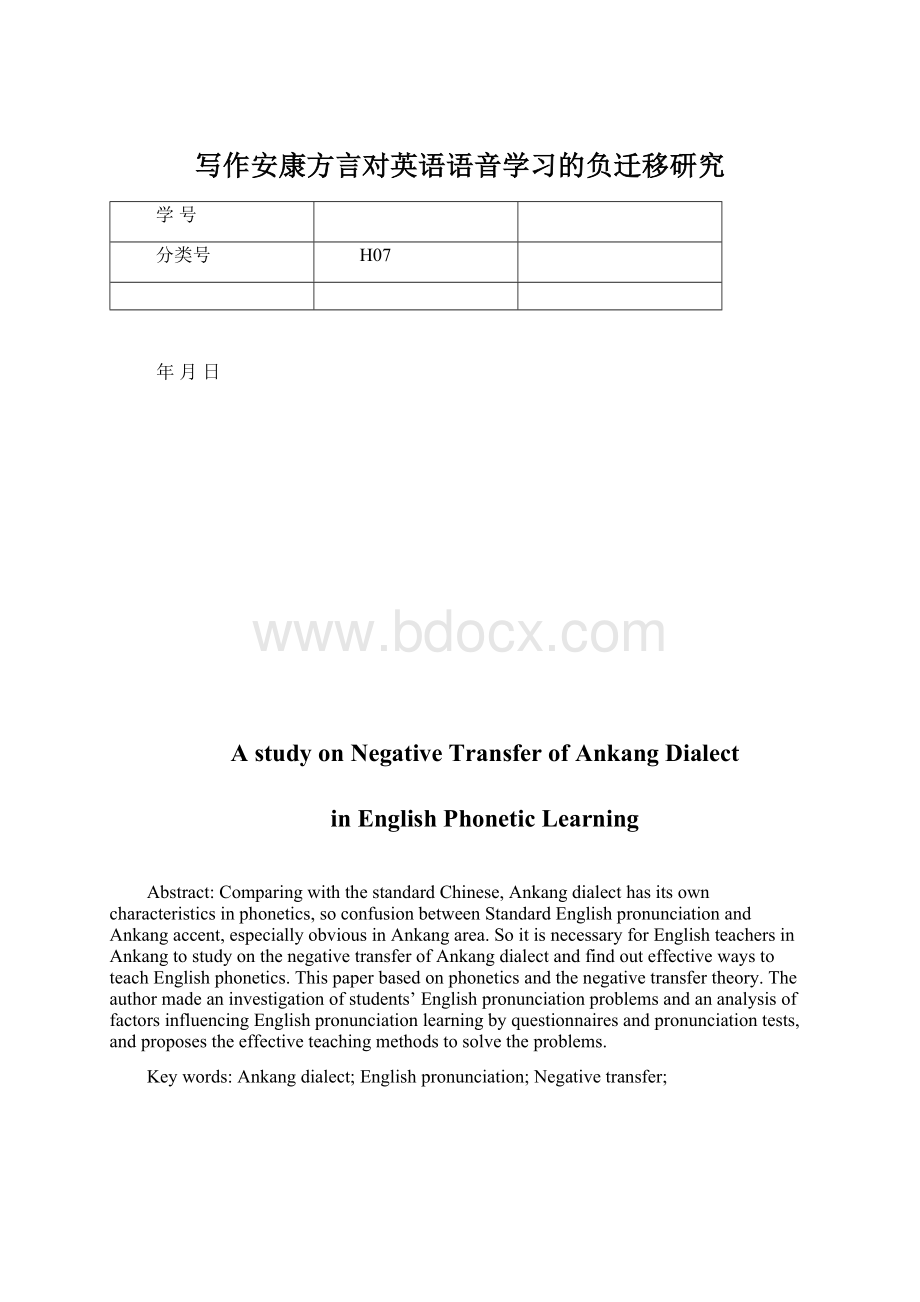写作安康方言对英语语音学习的负迁移研究.docx
《写作安康方言对英语语音学习的负迁移研究.docx》由会员分享,可在线阅读,更多相关《写作安康方言对英语语音学习的负迁移研究.docx(19页珍藏版)》请在冰豆网上搜索。

写作安康方言对英语语音学习的负迁移研究
学号
分类号
H07
年月日
AstudyonNegativeTransferofAnkangDialect
inEnglishPhoneticLearning
Abstract:
ComparingwiththestandardChinese,Ankangdialecthasitsowncharacteristicsinphonetics,soconfusionbetweenStandardEnglishpronunciationandAnkangaccent,especiallyobviousinAnkangarea.SoitisnecessaryforEnglishteachersinAnkangtostudyonthenegativetransferofAnkangdialectandfindouteffectivewaystoteachEnglishphonetics.Thispaperbasedonphoneticsandthenegativetransfertheory.Theauthormadeaninvestigationofstudents’EnglishpronunciationproblemsandananalysisoffactorsinfluencingEnglishpronunciationlearningbyquestionnairesandpronunciationtests,andproposestheeffectiveteachingmethodstosolvetheproblems.
Keywords:
Ankangdialect;Englishpronunciation;Negativetransfer;
安康方言对英语语音学习的负迁移研究
摘要:
由于安康地区方言的语音有自己独特的音系特征,在安康地区这种母语对英语语音学习的负面影响尤其明显。
为了提高安康学生的英语口语水平,有必要研究安康方言对英语语音的负迁移的影响,提出行之有效的解决方法。
本文从语音学和负迁移理论,以调查问卷和语音测试的方式,来分析安康方言对英语语音的负迁移作用的方面,并提出了克服安康方言负迁移的有效教学方法.
关键词:
安康方言;英语语音;负迁移
Contents
AbstractinEnglishi
AbstractinChineseii
Contentsiii
1.Introduction1
2.LiteratureReview1
2.1Studyabroad2
2.2Studyathome3
3.SoundsystemsofEnglishandAnkangdialect3
3.1PhoneticSystemofEnglish3
3.1.1TheConsonantsofEnglish3
3.1.2TheVowelsofEnglish4
3.2ThephoneticssystembetweenMandarinandAnkangdialect5
4.Researchdesign5
4.1Testingmaterials6
4.1.1TestmaterialsofEnglishConsonants6
4.1.2TestMaterialsofEnglishVowels6
4.2Participants7
4.3Instruments7
4.3.1Questionnaire7
4.3.2TheAudioTapeRecording7
4.4ProcedureofExperiment8
5.DataAnalysisandDiscussion8
5.1Theresultsofquestionnaire8
5.2ProblemsFoundthroughtheTestMaterials9
5.2.1Negativetransferontheconsonants9
5.2.2Negativetransferinvowelsounds10
6.Thestrategyofovercomingthenegativetransfer11
6.1Solutionsforvowels12
6.2Solutionsforconsonants13
7.Conclusion14
References15
Acknowledgements16
Appendix17
1.Introduction
ChinesestudentslearningEnglishphoneticsisgenerallyinfluencedbymothertonguespeech,especiallythenegativetransferofnativedialectspeech.AndthisproblemhasalwaysbeentheweakpointsofEnglishteaching,especiallyinthepoorruralareas.Studentsliveinruralareas,andlackingoflearningEnglishphoneticsknowledgeandscientificspeechtraining,sothereareagreatnumberofproblemsinEnglishpronunciation:
theirEnglishspokenareinfluencedbytheirdialectwithstrongcharacteristicsofdialects,ThisphenomenonisverycommoninAnkangEnglishphoneticsteaching,Embodiedinthesoundlevel,theyoftenuseAnkangdialecttoreplacesomeofEnglishvowelsandconsonants,orcannotpronouncethesoundwhichwithoutthephonemesinAnkangdialect;Thisissueismoreandmoreserious,butfewpeopleputforwardthesolutions,whichmakestheAnkangdialectareastudentsoralEnglishandlisteninglevelgenerallyinlowlevel.
Thispaperbasedonthetheoryofphoneticsandthenegativetransfertheory,bycomparingAnkangdialectandEnglishpronunciation,analyzingthedifficultiesinlearningEnglishpronunciation,findfeasibleeffectiveteachingmethodstoovercomenegativetransferofAnkangdialectonEnglishpronunciation.
Thesignificanceofthisstudyliesin:
(1)ThisresearchfocusonthenegativetransferofAnkangdialectovertheacquisitionofEnglishsounds,itwillshowEnglishpronunciationmistakesofthelocalstudents.Theresearchistryingtomakessomecontributionsforthisblankness;
(2)AnkangstudentswillknowtheirproblemsintheacquisitionofEnglishsoundsfromtheresultoftheresearch,itisusefultoavoidthenegativetransferoftheirdialect;(3)ThesignificancesandnecessityofthispaperistomakeaquiteclearanalysisaboutAnkangdialectandEnglishspeechsounds,whichwillhelpEnglishteachersinthisareatopromoteteachingandlearningmethods.
2.LiteratureReview
Thethesisismainlybasedonthetheoryoflanguagetransfer,whichwillbeintroducedbrieflyinthischapter,followedbyareviewoftherelevantresearchesbyinternationalanddomesticscholarsonlanguagetransferinlearning.
2.1Studyabroad
OdlinsaysinLanguagetransferthat,languagetransferhasbeenakeyissueofappliedlinguistics,secondlanguageacquisitionandlanguagestudiesforatleastacentury(Odlin,2001).Therearedifferentdefinitionsoftransfer.Ellisdefines“transfer”asahypothesisaboutthelearningofassignmentAwillinfluencethelearningofassignmentB.Jamesdefines“transfer”asatheoryoflearningnativelanguageandsecondlanguage.Themostconciseandexactdefinitionoftransferastheeffectcausedbysimilaritiesanddifferencesbetweenthetargetlanguageandanyotherlanguagesthathasbeenlearned(Odlin,1989).Mothertonguetransferreferstotheinfluencecausedbysimilaritiesanddifferencesbetweenmothertongueandsecondlanguage.Itisgenerallyacknowledgedthatthepositiveinfluenceiscalledpositivetransfer,negativeinfluencecallednegativetransfer.Positivetransferofmothertonguehelpsstudentstolearnsecondlanguage.Onthecountry,negativetransferofmothertonguewillinfluencestudents’secondlanguagelearning,anditcanbringerrorsforstudents.AsEllispointedout,onethingresponsibleformakingerrorsinlearninganewlanguageistheinfluenceofthemothertongue,andthisiswhatwecallnegativetransfer(Ellis,2000).AccordingtoCarruthers(Carruthers,2006),alllanguagesusecomponentsoundstoexpressmeaningandeachlanguagehasitsownsetofdistinctivesoundsorphonemes.Sowhenwelearnanewlanguage,wepaymoreattentiontoitssoundsthanotherformsofalanguage,especiallythepartswhichsounddifferentlyfromone'snativelanguage,whichalsomaybethedifficultieswhenlearningthenewlanguage.TheAmericanlinguistLadoputforwardinhisbookLinguisticsAcrossCulturesthatinthecontextofforeignlanguagelearning,learnersrelyextensivelyonone'snativelanguageandtendtotransferthelanguageform,meaningandcultureofmothertonguetoforeignlanguagelearning.(Lado,1957)MarxandMehlhom(MarxandMehlhom,2010)explorephoneticsimilaritiesbetweenEnglishandGermanwhichcanbeusedtopromotepositivetransferbylearnersofthetargetlanguageGermanandputforwardpedagogicalimplicationsformakingfulluseofthesesimilaritiesinlanguageteaching.
2.2Studyathome
ChinesescholarshavemadeattemptstostudytheinfluenceofChineseontheacquisitionofsecondlanguagephonetics.StudiesaboutphonetictransferofmandarinonEnglishwillbepresentedasfollows,
Moretheoreticalsupportwasrequiredforthephoneticteaching,andmorescholarsworkonthestudyofEnglishphonetics,lotsofresearchesandsomediscoverieshavebeenmadeinthisarea.Forexample,HeShanfen(何善芬,1988)publishedabooknamedPracticalEnglishPhonetics,ZhaoDemei(赵德梅,1995)introducedandcomparedtheEnglishandChinesemandarinphonologicalsystemsystematically,whichhelpslearnerstoknowwellthephoneticcharacteristicofEnglishandChinese.YuLiming’sLanguagetransferandsecondlanguageacquisitionreview,reflectionandresearch.Inthisbook,heputforwardthatstudentswhohaveacorrectunderstandingofmothertonguetransferwillpromotetheirforeignlanguagelearning(俞理明,2004:
198).Itisgenerallyfoundthetransferatthelevelofsoundsystem,probablybecausepronunciationisnotonlythemostbasiccomponentoflanguage,butalsothemostbasicformofcommunication(戴讳栋,何兆熊,2002).Thelanguagelearnersmispronouncewouldinfluencethecommonunderstandingandfluencyofcommunicationwithnativespeakers.InthearticleofThelexicallevelofnegativetransferofmothertongue,WuMingjunpointedoutthatundertheguidanceofthelanguagetransfertheory,EnglishteacherscancontrastandanalysisthedifferencesandsimilaritiesbetweenmothertongueandEnglishtomakestudentshaveabetterunderstandingofEnglish.Bydoingso,studentscanreducetheeffectofmothertonguenegativetransfer,improvelanguageacquisition,andpromotethequalityoflearning(吴明军,2004).InCNKI,retrievalthestudiesfrom1994to2015,thequantityofstudiesentitledlanguagetransferis550.Fromtheresults,conclusioncanbedrawnthatstudiesontheeffectofmothertonguetransferareincreasingyearbyyear.
3.SoundsystemsofEnglishandAnkangdialect
3.1PhoneticSystemofEnglish
3.1.1TheConsonantsofEnglish
Thereare28consonantsphonemes[p],[b],[t],[d],[k],[g],[h],[f],[v],[θ],[ð],[s],[z],[r],[ʒ],[dʒ],[tʃ],[tr],[dr],[n],[m],[r],[l],[ŋ],[ts],[dz],[j]and[w].Whenpronouncingittheairwillmeetanobstructionintheprocessofpronunciation.Englishconsonantscanbeclassifiedintwoways:
oneisintermsoftothemannerofarticulationandtheotherisintermsofplaceofarticulation.Thetwoclassificationsarecombinedinthetablebelow,whichcouldhelpusadequatelydescribeexactwayofthepronunciationofeachconsonants.
Table1MannersofEnglishconsonants(何善芬,2002:
12)
MannerofArticulation
Plosive
Affricative
Fricative
Nasal
Lateral
Approximant
-v
v
-v
v
-v
v
v
v
v
Asp
-Asp
Asp
Asp
Bilabial
[p]
[b]
[m]
[w]
Labiodental
[f]
[v]
Dental
[θ]
[ð]
Alveolar
[t]
[d]
[s]
[z]
[n]
[l]
Post-alveolar
[r]
Palatal-alveolar
[t∫]
[dʒ]
[ʃ]
[ʒ]
Palatal
[j]
Velar
[k]
[g]
Glottal
[h]
(Notes:
vreprese